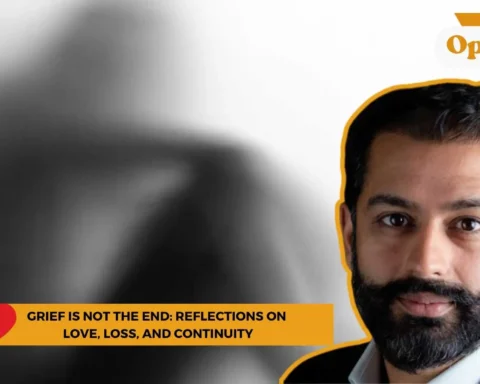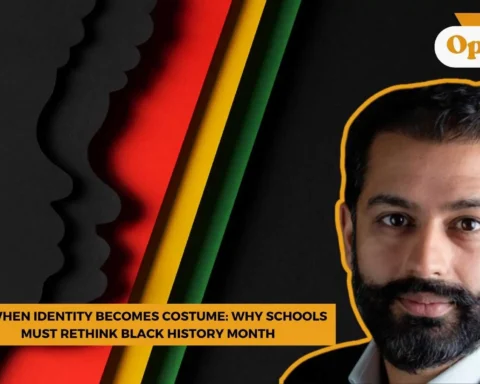A disturbing video surfaced recently: two young Sikh men, both appearing Amritdhari, clothed in the visible markers of faith, engaged in a chilling act of violence. One held a knife to the other’s throat. It was not just a physical confrontation; it was symbolic, a blade pressed against the throat of everything those symbols were meant to represent. In that moment, I saw more than a personal dispute. I saw the evolution of an identity war that stretches beyond Birmingham and echoes across diasporic communities globally.
But let’s be honest. This isn’t just a crisis of youth.
It’s also about my generation. And the generation before mine.
We often romanticize our past, speak with nostalgia of a time when we supposedly carried faith like a sacred flame. But the truth is more sobering: we didn’t. We quickly substituted faith for money. Where our inheritance was meant to be grounded in equality and justice, we instead chased property portfolios and luxury cars. The markers of success became external: Mercedes-Benz over meditation, financial status over fairness. And that silent trade-off came at a cost we’re only now beginning to comprehend.
The disdain between religion and deeds, ideas and actions, was always there, subtle but corrosive. We wore our faith proudly but seldom practiced its depths. We built Gurdwaras, but did not always build understanding. And now that chasm has widened, played out in real-time on the streets, where a generation is struggling to reconcile symbols of peace with acts of violence.

From Street Violence to Symbolic Crisis
Birmingham has seen its share of violence. I remember the 1980s, racial attacks, the rise of the far-right, and the raw hostility many of us grew up with. Then came the glamorisation of gang culture, fed by TV, music, and an undercurrent of survivalism. But today’s tensions are something more abstract, more internalised. The battles are no longer just between communities; they are within communities, within individuals. And perhaps most dangerously, they are cloaked in the garments of faith.
The youth today are more socially connected than ever before. But that also means they are more exposed, bombarded with content, narratives, and imagery that shape their view of masculinity, status, and power. They are raised on a digital diet that blends music with machismo, protest with ego, and culture with clout. They are more influenced by stories, true or not, than ever before.
And in the vacuum of real, grounded leadership, self-appointed custodians have stepped in. Individuals who, in pursuit of popularity and adoration, perpetuate a brand of identity that’s more about performance than principle. And perhaps the most dangerous drug of all is adoration, because when applause becomes a form of currency, truth becomes a liability.
Attire Without Anchor
Religious symbolism should anchor us. But too often, it has become surface-level. The kirpan, the turban, the kara, these are not accessories. They are profound commitments to justice, humility, and service. Yet in the current identity war, these symbols are being weaponised, sometimes literally.
In diasporic communities, this dislocation is amplified. We see similar dynamics among Muslim, Hindu, African-Caribbean, and white working-class youth. Each group faces its own version of identity fatigue, where culture is inherited but never fully explained, and tradition is emulated without context.
The crisis isn’t that our youth don’t care—it’s that they are being handed fragments of identity with no framework for assembly. They are inheriting stories, grievances, pride, and pain, but no compass.

Performance Over Principle
Visit Smethwick today. Walk into a restaurant, listen to the soundtrack of modern life. Violence, power, and bravado, all delivered in the sleek packaging of music videos and social media reels. And it’s not just the youth celebrating this, many in our generation consume it too, passing it on, normalising it, even admiring it.
We measure our children’s success in grades and grammar, but not in grit or grace. We’ve taught them to perform religion for weddings, for photos, for occasions, but not how to live it on the quiet days, in the unseen moments. In this sense, we have all played a part in diluting what we claim to protect.
So when violence erupts in the name of honour or faith, we should ask ourselves: did we really expect anything different?
Community Without a Compass
We have institutions: Gurdwaras, cultural centres, and associations. But what we don’t have is a shared vision. Where are we going? Who are we becoming?
We fight over political affiliations, over religious ideologies, over imagined enemies across the world. And while we debate who should sit on the panel, our youth are absorbing their ideologies from influencers who don’t even live in our communities. This issue is a microscopic mirror of what is happening on a global scale. It’s systemic, digital, and deeply personal.
And no amount of Gurdwara committee meetings is going to fix it. Because those meetings often descend into the same egotistical games, whose ideas matter most, who speaks longest, who gets the final word.

What Will Fix It?
Honest, open conversations—difficult ones. Conversations where we ask: Who are we? Who are we becoming? Where do we go from here?
That means hearing all voices. It means talking not just about the youth, but to them. About mental health. About women’s empowerment. About interfaith dialogue, not as tokenism, but as a real search for common ground. About our place in society, not just as ethnic minorities, but as citizens with responsibility. It means looking at culture, faith, and power, and then looking in the mirror.
Because right now, we are a ship without a rudder. And my deepest fear is that we are simply reacting to headlines rather than responding to truths.
A Legacy at Risk
There’s a Sikh saying: “Mann Jeetay, Jag Jeetay” — “Conquer the mind, conquer the world.” But our minds are unguarded, our hearts unanchored. We react not from Sikhi, but from shame. And I can’t help but feel that some of us are calling for peace now, not because we understand our ideals, but because we’re embarrassed by the headlines. We’ve fallen into the trap of preserving image over essence.
But Sikhi is not about steel or shouting. It’s about sehaj—equilibrium, wisdom, truth. It’s about justice that includes women, children, and the voiceless. It’s about equality of thought and action, not just appearance.
If we’re going to call ourselves a community, we must also take responsibility for the ecosystem we’ve created. For every generation that placed money over meaning, status over service, we owe an apology. And more than that, we owe a path forward.
A Call to Consciousness
This article is not a solution. It’s a mirror. Why, and perhaps that’s where we must begin—by seeing things clearly, by naming what hurts, and by choosing courage over comfort.
Our youth are not lost causes. They are reflections. Let’s show them something worth reflecting on.
Let’s stop the identity wars by rediscovering the identity worth fighting for.
But here’s the question we must all ask ourselves—whether we’re elders, activists, parents, or leaders: If our youth are inheriting the shadows of our silence, what truth are we willing to speak today to stop the next blade from being drawn tomorrow?
Because if we don’t ask it now, we may soon find ourselves not just mourning a generation, but losing it altogether.

Let us know your thoughts. If you have burning thoughts or opinions to express, please feel free to reach out to us at larra@globalindiannetwork.com.









